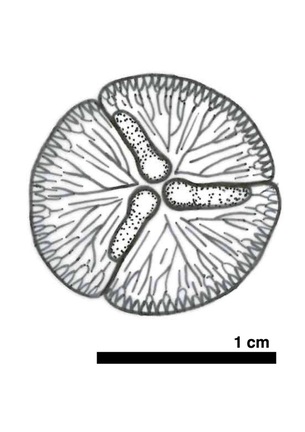albumares brunsae
fedonkin, 1976
|
Albumares brunsae was a small discoidal organism with tri-radial symmetry. Distinct from Rugoconites and Tribrachidium, the bifurcating ridges in Albumares are comparably fine. However, similar to Rugoconites and Tribrachidium, Albumares has three convex structures at one edge of each lobe that appear to meet in the centre of the organism. This basic but significant similarity may suggest that the three genera are relatively closely related.
Anfesta stankovskii (Fedonkin, 1984) is a tri-radial fossil that is morphologically comparable to Albumares brunsae (Fedonkin et al., 2007), the only difference being that Albumares has more numerous bifurcating ridges. It is possible that Anfesta and Albumares are taphomorphs of the same genera. Described from: Flinders Ranges, South Australia White Sea, Russia Key references: Fedonkin, 1984 Fedonkin et al. 2007 Keller & Fedonkin, 1977 Fedonkin, M.A., 1984. Promorphology of Vendian Radialia. In: Stratigraphy and Paleontology of the most Ancient Phanerozoic. Ivanovsky, A.B. & Ivanov, A.B., eds, Moscow, 30-58. Fedonkin, M.A., Gehling, J.G., Grey, K., Narbonne, G.M. & Vickers-Rich, P., 2007. In The Rise of Animals. Komarower, P., eds, Maryland, The Johns Hopkins University Press, 89-112. |
Diagnosis: (from Keller & Fedonkin, 1977):
Impression of a small medusa with a flattened, hemispherical umbrella, or bell, characterized by radial symmetry of three rays. From center of bell emerge three mouth lobes, preserved in the form of small ridges. They begin with small flattenings, become thinner toward the peripheral part, and end in small tubercles at its edge. The medusa's body was evidently very thin and delicate, inasmuch as the impressions have preserved a system of thin radial bifurcating ridges - traces of the gastrovascular system. In each of the three sectors of the medusa's body, separated by the mouth lobes, three canals extend from the centre, bifurcating four times toward edge of bell. No traces of an annular canal or of gonads can be seen. Along its edge the bell disc bears a large number of impressions of thin, short tentacles, whose number exceeds 100.
Impression of a small medusa with a flattened, hemispherical umbrella, or bell, characterized by radial symmetry of three rays. From center of bell emerge three mouth lobes, preserved in the form of small ridges. They begin with small flattenings, become thinner toward the peripheral part, and end in small tubercles at its edge. The medusa's body was evidently very thin and delicate, inasmuch as the impressions have preserved a system of thin radial bifurcating ridges - traces of the gastrovascular system. In each of the three sectors of the medusa's body, separated by the mouth lobes, three canals extend from the centre, bifurcating four times toward edge of bell. No traces of an annular canal or of gonads can be seen. Along its edge the bell disc bears a large number of impressions of thin, short tentacles, whose number exceeds 100.

